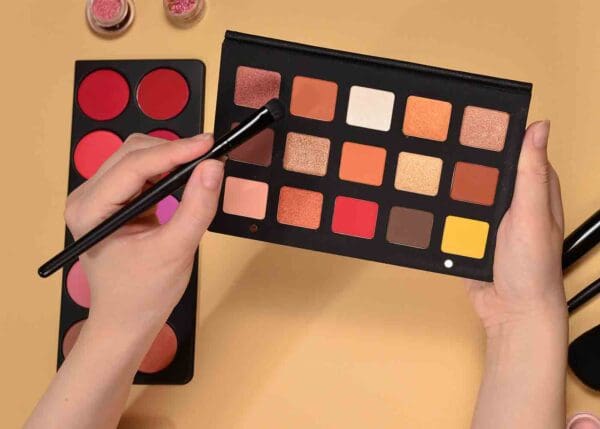01. Asbestos Use in Makeup
Why Is Asbestos in Makeup?
Many commercial makeup products contain talcum powder. Talcum powder is made of talc, a mineral found naturally near asbestos. When talc is mined for use in cosmetics, asbestos fibers may be disturbed. As a result, talc products can be contaminated with asbestos. Exposure to asbestos can lead to mesothelioma and other asbestos cancers.
Asbestos Makeup History at a Glance
- Contaminated Ingredient Names: Talcum powder, talcum, talc, cosmetic talc, magnesium silicate
- Currently Used? Yes
- Places Used: Blush, bronzer, contour palettes, eyeshadow, face powder, powder foundation
- Asbestos Use Banned: No
- Noteworthy Brands: Beauty Plus Global Inc., Claire’s©, Johnson & Johnson
Talc is currently an ingredient in many popular products. It can be found in baby powder, makeup palettes and other cosmetic goods. Talc contaminated with asbestos can pose a serious health threat. Individuals who manufactured or used these asbestos products may be at risk of developing mesothelioma.
Other Names for Talc in Cosmetics
Makeup products may list talc under different names in their list of ingredients. Other names for talc in cosmetics include:
- Cosmetic talc
- Magnesium silicate
- Talc
- Talcum
- Talcum powder
Products containing talc under any name may be contaminated with asbestos. Talc helps these products feel smooth and absorb moisture, but alternatives to talc in makeup exist. These alternatives are designed to provide the same benefits of talc without the dangers.
Dangers of Asbestos in Makeup
Asbestos exposure can lead to the development of serious asbestos-related diseases. Talc can be dangerous because it may contain asbestos fibers. Studies have found different forms of cancer may be caused by exposure to asbestos-contaminated talc.
Some research suggests a link between asbestos-contaminated talc and certain types of cancer, including mesothelioma and ovarian cancer.
One study tested whether it is possible to inhale asbestos fibers in cosmetic talc products. Researchers tested one talc-based product. The samples were manufactured over a 50-year period. Results confirmed that applying talcum powder would result in airborne asbestos that could be dangerous if inhaled.
Further research from 2020 tested 21 talc products for asbestos. The study authors found asbestos in 14% of the products, including one marketed for children.
The nature of contaminated makeup may make it especially dangerous. Many cosmetic goods are placed on the face, particularly around the nose and mouth. This may make inhalation and ingestion more likely.
02. Talc in Cosmetics
Talcum Powder Use in Makeup
Talc is a common ingredient used in makeup. It is most common in powder-based products, such as eyeshadows, blush and powder foundation. Companies use talc in makeup for a variety of reasons. Among them, talc can help absorb moisture and smooth or soften cosmetics for a better feel.
Is Talc Safe in Makeup?
Questions about whether talc is completely safe still exist, but as of now there is no proven link between talc and cancer. However, asbestos is linked to diseases like mesothelioma cancer and asbestosis. In the United States, cosmetic talc regulations are limited. As a result, many asbestos-contaminated, talc-based products continue to reach consumers.
The use of asbestos-contaminated talcum powder in consumer products has been a building issue in recent years. In October 2019, Johnson & Johnson recalled 33,000 bottles of baby powder after the U.S. Food and Drug Administration (FDA) found trace levels of asbestos in the product.
The discovery of asbestos in a popular household brand sparked research, lawsuits and awareness around the dangers of contaminated talc. In August 2022, Johnson & Johnson announced it would be ending global sales of its talc-based baby powder in 2023. It will replace the talc in its baby powder with corn starch.
Talcum Powder and Cancer
Scientific research has not established a link between talc and cancer. However, exposure to asbestos in contaminated talc cosmetics could lead to mesothelioma and other asbestos-related diseases.
People who may have been exposed to asbestos-contaminated talc makeup products can speak to a doctor. A doctor can watch for early symptoms of mesothelioma. Mesothelioma treatment may be more effective when the disease is diagnosed in its early stages.
Patients who develop mesothelioma can seek treatment at qualified cancer centers. Mesothelioma doctors at these centers can develop individualized treatment plans designed to improve patients’ prognoses.
Are There Talcum Powder Alternatives?
Cosmetic formulas continue to evolve, incorporating alternatives for talcum powder.
Ingredients that may provide similar benefits include:
- Corn starch
- Kaolin
- Rice powder
- Rice starch
- Silica
- Tapioca starch
- Zinc oxide
Researchers have not thoroughly tested the safety of every alternative in this list. And in the case of silica, exposure to this mineral can cause lung diseases. Consumers may want to stick to alternatives that use foods that are safe for people to eat, like corn starch and rice starch.
Some brands offer both talc and talc-free products. Other brands are completely talc-free. These talc-free products may be a good alternative for consumers wishing to avoid talc altogether.
03. Asbestos in Children’s Makeup
Asbestos in Children’s Makeup Products
Children are at risk of asbestos exposure from contaminated talc-based cosmetics for kids. In recent years, asbestos has been found in children’s makeup sold by companies like Claire’s and Justice. Because mesothelioma may take decades to develop, people exposed to asbestos as children risk developing the disease later in life.
Current regulations do not require every talc product be tested for asbestos. As a result, there could be other contaminated products being marketed to children. While federal agencies and consumer watchdog groups continue to investigate products, parents may find it easier to cut out talc products entirely.
Retailers often have contracts with specific suppliers to create their makeup products. Despite the well-known dangers of asbestos, suppliers continue to deliver contaminated talc. This includes suppliers in the United States and overseas.
Activist group Environmental Working Group (EWG) warns toy makeup kits are often made with cheap ingredients like talc. Asbestos contamination is a known risk in talc products. EWG’s Vice President for Healthy Living Science, Nneka Leiba, voiced her concerns. She stated profits are not as important as protecting children from a carcinogen such as asbestos.
04. List of Asbestos Makeup
Makeup Products Containing Asbestos
As claims of asbestos in cosmetics emerge, the FDA and independent groups actively investigate these products. For instance, the FDA has performed testing for beauty products sold at Claire’s and Justice to confirm the presence of asbestos.
Makeup products confirmed to contain asbestos include:
| Product Name |
|---|
| Avon Bird of Paradise Powder |
| Avon Skin So Soft Satin Talc Powder |
| Avon Unforgettable Powder |
| Beauty Plus Global Inc. City Color Collection Matte Blush (Fuchsia) – Lot No. 1605020/PD-840 |
| Beauty Plus Global Inc. City Color Cosmetics Timeless Beauty Palette – Lot No. 1510068/PD-C864R |
| Beauty Plus Global Inc. City Color Bronzer (Sunset) – Lot No. 160634/PD-P712M |
| Beauty Plus Global Inc. City Color Shimmer Bronzer (Caramel) – Lot No. 1612112/PD-840 |
| Beauty Plus Global Contour Effects Palette 2 – Batch No. S1603002/PD-C1179 |
| Claire’s Eye Shadows – Batch No/Lot No: 08/17 |
| Claire’s Compact Powder – Batch No/Lot No: 07/15 |
| Claire’s Contour Palette – Batch No/Lot No: 04/17 |
| Claire’s JoJo Siwa Makeup Set – Batch/Lot No. S180109 |
| IQ Toys’ Princess Girl’s All-in-One Deluxe Makeup Palette |
| Jmkcoz’s 120 Colors Eyeshadow Palette Makeup Kit |
| Jmkcoz’s Beauty Glazed Gorgeous Me Eye Shadow Tray Palette |
| Justice’s Just Shine Shimmer Powder |
The FDA is investigating other products to determine the presence of asbestos. Those items are not listed. New cases of asbestos in makeup continue to emerge.
A variety of companies have produced asbestos-contaminated cosmetic products. Many of these brands are household names. Several are also marketed directly to children, such as Claire’s.
05. Makeup & Asbestos Exposure
Who Is at Risk of Asbestos Exposure From Makeup?
Anyone who uses talc-based makeup contaminated with asbestos may be at risk of exposure. This includes both adults and children who use cosmetic products. People who mine the talc used in cosmetics may also risk asbestos exposure. Individuals exposed to this dangerous mineral may develop an asbestos disease, like lung cancer or mesothelioma.
In general, asbestos exposure can affect individuals at work, home and school. However, non-occupational exposure, a category which includes cosmetic exposure, is a common cause of mesothelioma in women.
Exposure can have serious health implications at any age or level of exposure.
06. Safety Precautions
Safety Precautions for Asbestos Cosmetics
Individuals should always be aware of the dangers of asbestos contamination in talc cosmetics. The FDA and EWG will occasionally issue warnings when there are concerns around consumer products. Adults should exercise caution when purchasing a talc-based product for themselves or children.
Precautions can be taken to protect children and adults from the dangers of asbestos in cosmetics. People may want to read labels to see if the product contains talc, watch out for recalls and look for products labeled talc-free.
Consumers should be aware of what ingredients are in their products.
If there is asbestos in a product and an individual has been exposed, symptoms of an asbestos illness could take years to develop. If symptoms of mesothelioma or another asbestos condition arise, seek medical care as soon as possible to aid early diagnosis.
07. Asbestos Testing
Testing for Asbestos in Cosmetics
Researchers testing for asbestos in cosmetics may use microscopic analysis, also called microscopy. Individual asbestos fibers are microscopic and invisible to the naked eye. Microscopy can help researchers determine the presence of asbestos in talc cosmetics.
Stores such as Claire’s and Justice use labs certified by the International Organization for Standardization (ISO) to test their products. However, the organization may not use the most sensitive testing methods. This could lead labs to consider a product asbestos free when there are still harmful fibers present.
08. Asbestos Regulations
Regulations for Cosmetics With Asbestos
Asbestos in the cosmetics industry is poorly regulated in the United States compared to asbestos in other industries. The dangers of asbestos have been well known since the 1960s. In the late 1970s, federal agencies began to regulate asbestos use in many industries, but not in cosmetics. Attempts to ban the mineral entirely have not been successful.
Awareness of the need for stricter talc regulations emerged in the late 1970s. Until recently, little progress has been made to establish federal legislation ensuring talc products are asbestos free.
Who Is Responsible for Cosmetic Safety?
The FDA is responsible for regulating the cosmetics industry, including talc makeup products that may contain asbestos. However, the agency has very little power over cosmetic companies. Companies are not legally required to test their products for safety. They also do not have to provide lists of product ingredients to the FDA. The FDA is also unable to recall products. It can only encourage companies to recall harmful products voluntarily.
The FDA does conduct research into the presence of asbestos in cosmetics. Sometimes they begin research after consumers or independent researchers express concerns about a product. The agency has also recently begun routine testing of talc products.
The events surrounding Johnson & Johnson baby powder and Claire’s makeup have sparked conversations with advocates and key stakeholders. Concerns surrounding federal legislation and inadequate FDA standards for asbestos testing have led to recent calls for action.
One possible solution to the lack of regulation is for the Environmental Protection Agency (EPA) to step in and ban asbestos entirely. The EPA has the authority to ban asbestos. It is currently evaluating health risks that could result in a full ban on asbestos in the U.S.
Consumer watchdog groups are also instrumental in cosmetic safety. Though they have no power to change regulations, these groups often act as whistleblowers to alert consumers to dangerous products.
What Are Asbestos-Free Cosmetics?
Products labeled talc-free may be labeled as such to address concerns about the risk of asbestos contamination. These talc-free products may use talc substitutes to advertise to consumers that the makeup is asbestos-free. Consumers may choose to buy talc-free makeup to avoid the risk of asbestos contamination in talc.
Consumers who choose to buy talc-containing makeup may risk exposure to asbestos. Cosmetic companies are not required to safety test makeup before selling it. As a result, the fact that a talc cosmetic is sold on the market is no guarantee of its safety.
09. Asbestos Lawsuits
Asbestos Lawsuits, Settlements and Other Compensation
Individuals with an asbestos disease caused by exposure to contaminated talc may want to seek compensation. Compensation awards for cosmetic exposure may come in the form of lawsuit verdicts or settlement agreements. Victims may also be able to seek compensation from asbestos trust funds.
Successful mesothelioma lawsuits can serve many purposes, including:
- Assisting with medical costs
- Covering lost wages
- Holding negligent asbestos companies responsible
- Setting precedent for future asbestos exposure cases
Asbestos victims can contact a mesothelioma lawyer to file a case. Lawyers at experienced law firms can help meet any deadlines outlined in a state’s statutes of limitations and help with every step of the litigation process. They can also help victims explore other asbestos claim options.
10. Asbestos Cosmetics News
News and Recalls on Asbestos in Cosmetics
Asbestos in talc-containing makeup has been in the news in recent years. Stories include regulatory developments, recalls for asbestos-contaminated products and more. Companies like Beauty Plus Global, Claire’s and Justice have all recalled cosmetics in recent years.
The FDA and independent research groups continue to test makeup products with talc for asbestos.



